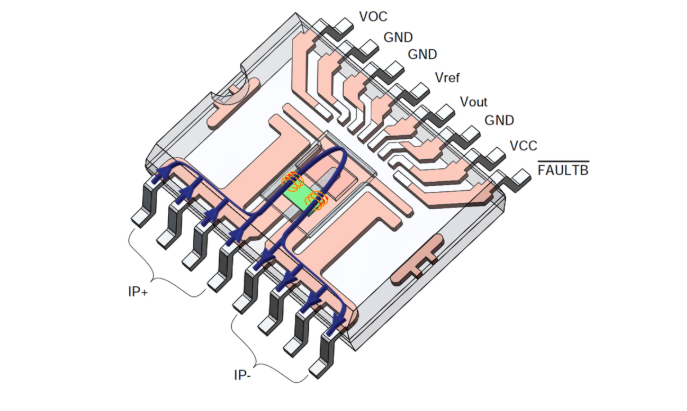Magical New Current Sensor Will Make Power Supplies
Smaller and Cheaper
Power supply circuits are literally everywhere. From the ubiquitous power bricks that recharge our phones to kilowatt server supplies in data centers, every modern electrified gadget has a switched-mode power supply circuit. Who wants to carry around a heavy laptop brick? What data center does not want to drive energy cost down while at the same time increasing compute capacity? These are just a few of the challenges facing today’s power supply designer.

Current Sensors Are Used in Numerous Power Applications
Size, cost, and efficiency are the three parameters universally desired in power supply design. Power supply designers have invented ever more sophisticated topologies to optimize these parameters. Long gone are the days of a simple three-terminal linear voltage regulator like the classic LM7805 .
Now topologies as complex as resonant LCC converters which use digital processing techniques to frequency-modulate the switching frequency above 1MHz are commonplace. In addition, regulations requiring power-factor correction as well as the increasing demand for high-voltage, high-current power supplies have led to a near revolution in sophisticated design techniques. At the heart of many of these new power architectures is the need for an accurate isolated high-bandwidth (1MHz+) current sensor. The current sensor has several roles, and it is often used to dynamically control the switching frequency to minimizes losses across the switching transistors. This technique is known as zero-current and zero-voltage switching or abbreviated ZCS/ZVS. The idea is that any current or voltage across a switching transistor during the switch phase is just wasted energy. Accurate and fast current measurement is the key to reducing that loss.
ACEINNA’s new family of Anisotropic Magnetoresistive (AMR) isolated current sensors offer design engineers a new operating point for accuracy and bandwidth in a small low-cost surface-mount package. In comparison to the real-world design compromises faced with Sense Resistors, Hall-Effect Devices, and Current Transformers, an AMR-based current sensor can seem almost magical. Instead of spending hours tweaking and isolating a sense-resistor or concocting a custom current transformer, a designer simply drops in the ACEINNA AMR-based current sensor. These devices feature UL certification with 4.8kV of input to output isolation, so they conform to safety standards that help prevent electrocution and other electrical hazards inherent in high-power design.
The ACEINNA AMR-based current sensor is comprised of a special NiFe thin film that exhibits a very high-sensitivity and high-bandwidth response to magnetic fields. AMR has inherently high-bandwidth and low-noise. In other applications, AMR sensors are used for measuring Earth’s magnetic field and even nano-Gauss level magnetic anomaly detection. The Bio-Savart law dictates that a current flowing thru a conductor, in this case the sensors cleverly designed lead-frame, will produce a magnetic field. Combining the two physics principles, an AMR material makes a very sensitive and high-bandwidth current sensor.
In the ACEINNA family of current sensors, this high-sensitivity is combined with special circuitry and packaging techniques to minimize drift.

ACEINNA Current Sensor Diagram with Symmetric Stray-Field Cancellation
In addition the combination of a symmetric sensor design, and the natural in-plane sensitive-axis of the AMR film offers exceptional stray field rejection.The design features a micro-ohm low-loss lead frame as the sensor primary, and a simple calibrated analog output for readout.
The table below shows some of the benefits of the ACEINNA AMR-based current sensor as compared to other traditional choices. Relative to sense resistors, an ACEINNA AMR-based device offers inherent isolation and reduced parasitic power loss. Relative to Current Transformers, ACEINNA AMR-based sensors provide DC-response, smaller-size, and better bandwidth. Relative to Hall-effect sensors, ACEINNA AMR-based sensors are more accurate and offer a wider, flatter frequency response curve. Best of all while providing all these benefits, an ACEINNA AMR-based device likely won’t hurt your bill of materials cost either.

ABOUT ACEINNA
ACEINNA Inc., is a leading provider of sensing solutions for automotive, industrial, telecom, datacenter, agricultural and construction markets.
ACEINNA’s precise positioning solutions are MEMS based, open-source, inertial sensing systems that are leading the industry by enabling easy-to-use, centimeter-accurate navigation systems for the autonomous revolution. ACEINNA’s current sensor product family is based on AMR technology that enables industry leading accuracy, bandwidth and step response in a cost effective single-chip form factor. ACEINNA has R&D facilities in San Jose, CA; Andover, MA; and Chicago, IL; as well as manufacturing facilities in Wuxi, China.
FOR MORE INFORMATION
ACEINNA Inc., One Tech Drive, Suite 325, Andover, MA 01810
Tel: 978-965-3200 Fax: 978-965-3201
Email: info@aceinna.com
Tel: 978-965-3200 Fax: 978-965-3201
Email: info@aceinna.com